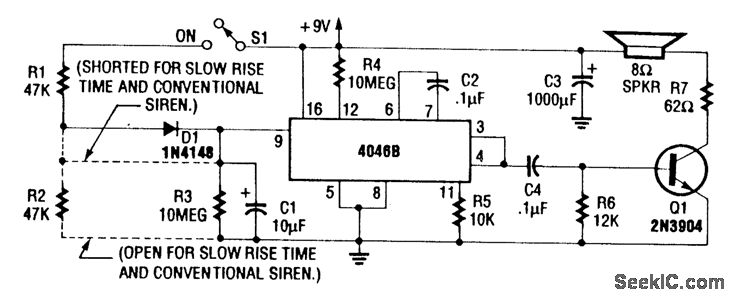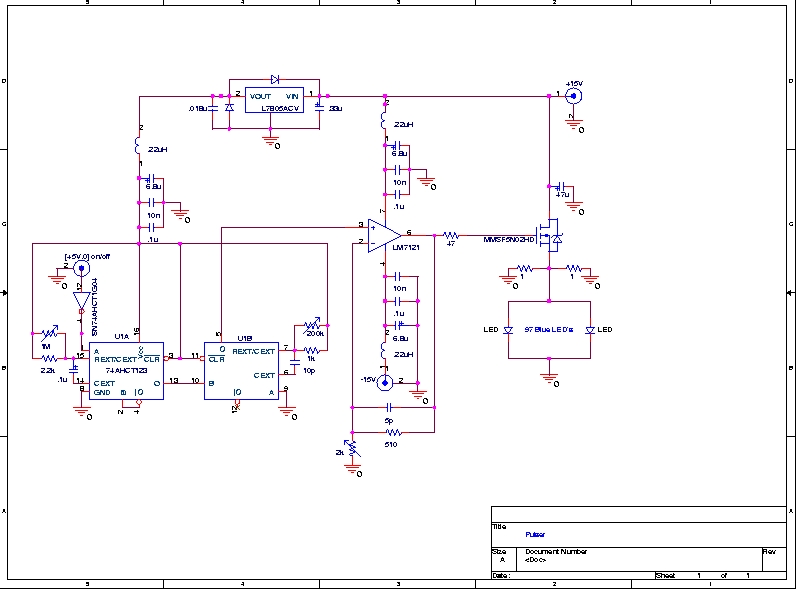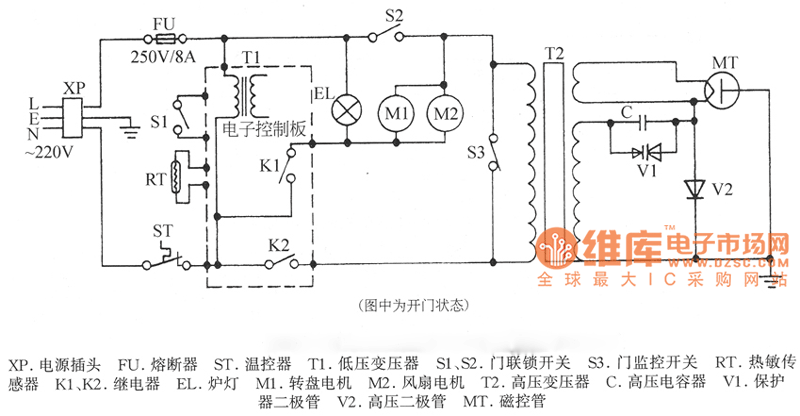
ELECTRONIC SIREN

For a normal wailing tone, short D1 and leave R2 open. To achieve a fast rise and slow fall in frequency, include both D1 and R2. Utilizing a CD4046B with a diode-RC network as illustrated generates a siren tone through a voltage-controlled oscillator (VCO).
The circuit utilizes the CD4046B phase-locked loop (PLL) integrated circuit, which is adept at generating various frequency tones, including siren tones. The VCO within the CD4046B is key to producing the desired audio frequency output.
In the configuration for a normal wailing tone, the diode D1 is shorted, effectively bypassing it, while resistor R2 is left open. This configuration allows the VCO to operate at a steady frequency, resulting in a continuous wailing sound. The absence of R2 means that the timing capacitor associated with the VCO discharges quickly, contributing to the wailing effect.
To modify the circuit for a fast rise and slow fall frequency response, both D1 and R2 must be included in the circuit. The presence of R2 introduces a time constant that slows down the discharge of the timing capacitor, thereby creating a gradual decrease in frequency. This results in a siren tone that rises quickly and falls slowly, mimicking the sound of emergency vehicle sirens. The diode D1 in this configuration acts to shape the waveform produced by the VCO, ensuring that the frequency modulation occurs as intended.
The diode-RC network plays a crucial role in shaping the output waveform and controlling the frequency characteristics of the siren tone. By adjusting the values of R2 and the timing capacitor, the designer can fine-tune the rise and fall times of the frequency modulation, allowing for a versatile range of siren tones suitable for various applications.For normal wailing tone, short D1 and open R2. For fast rise and slow fall in frequency, include D1 and R2. Use of a CD4046B with a diode-RC network as shown produces a siren tone, using a VCO. 🔗 External reference
The circuit utilizes the CD4046B phase-locked loop (PLL) integrated circuit, which is adept at generating various frequency tones, including siren tones. The VCO within the CD4046B is key to producing the desired audio frequency output.
In the configuration for a normal wailing tone, the diode D1 is shorted, effectively bypassing it, while resistor R2 is left open. This configuration allows the VCO to operate at a steady frequency, resulting in a continuous wailing sound. The absence of R2 means that the timing capacitor associated with the VCO discharges quickly, contributing to the wailing effect.
To modify the circuit for a fast rise and slow fall frequency response, both D1 and R2 must be included in the circuit. The presence of R2 introduces a time constant that slows down the discharge of the timing capacitor, thereby creating a gradual decrease in frequency. This results in a siren tone that rises quickly and falls slowly, mimicking the sound of emergency vehicle sirens. The diode D1 in this configuration acts to shape the waveform produced by the VCO, ensuring that the frequency modulation occurs as intended.
The diode-RC network plays a crucial role in shaping the output waveform and controlling the frequency characteristics of the siren tone. By adjusting the values of R2 and the timing capacitor, the designer can fine-tune the rise and fall times of the frequency modulation, allowing for a versatile range of siren tones suitable for various applications.For normal wailing tone, short D1 and open R2. For fast rise and slow fall in frequency, include D1 and R2. Use of a CD4046B with a diode-RC network as shown produces a siren tone, using a VCO. 🔗 External reference





